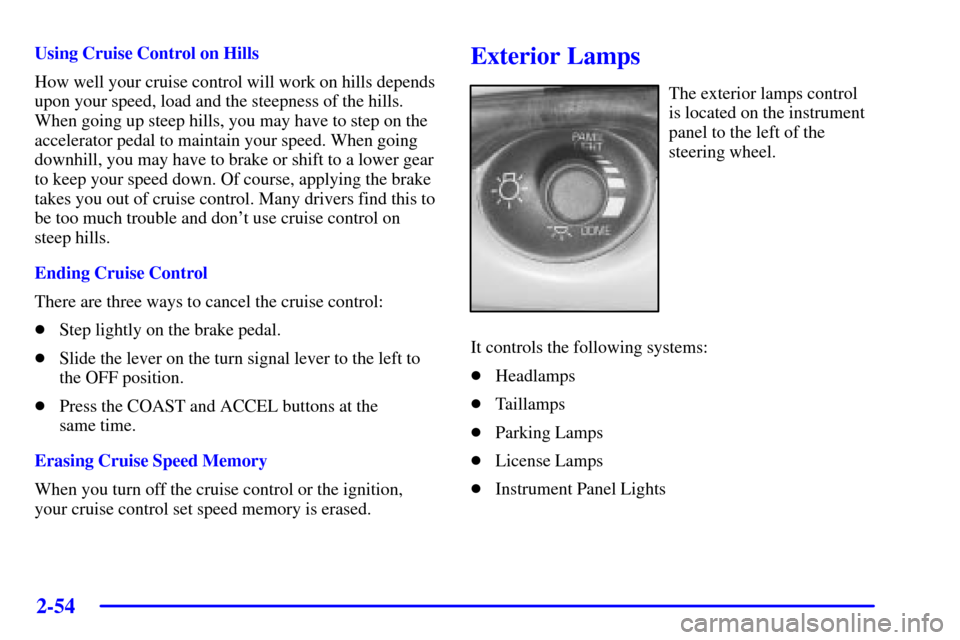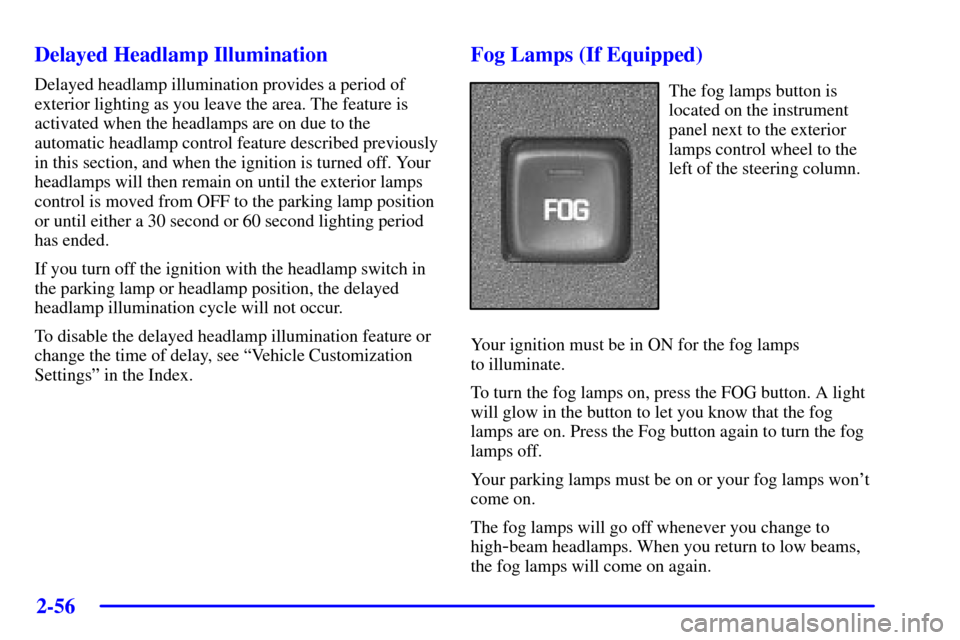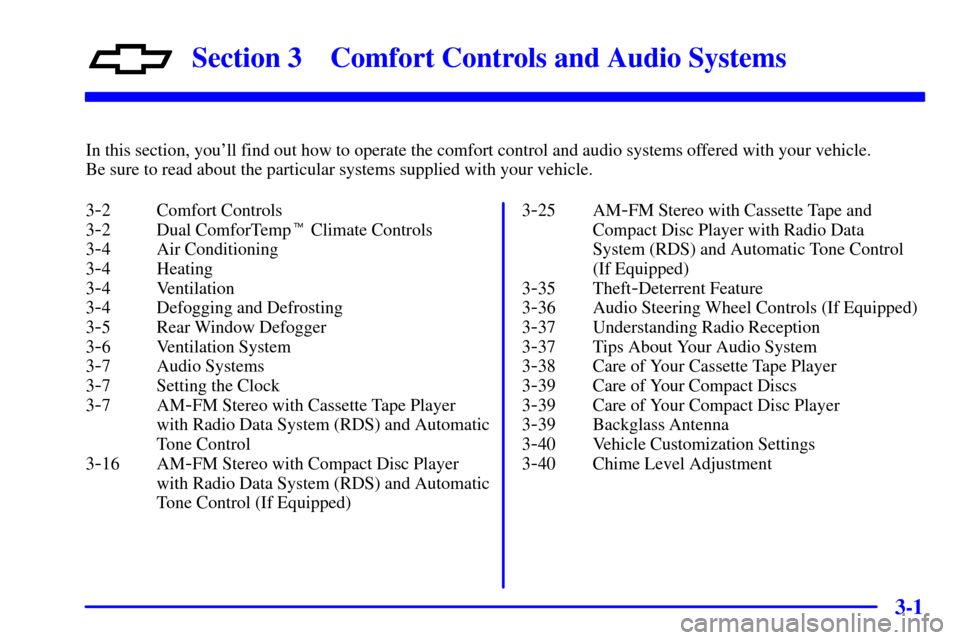Page 119 of 397

2-53
Increasing Speed While Using Cruise Control
There are two ways to go to a higher speed:
�Use the accelerator pedal to get to the higher speed.
Press the SET button on the steering wheel, then
release the button and the accelerator pedal. You'll
now cruise at the higher speed.
�Press the ACCEL (Accelerate) button on the
steering wheel. Hold it there until you get up to
the speed you want and then release the button.
(To increase your speed in very small amounts,
press the ACCEL button briefly and then release it.
Each time you do this, your vehicle will go about
1 mph (1.6 km/h) faster).
The accelerate feature will only work after you set the
cruise control speed by pressing the SET button on the
steering wheel.Reducing Speed While Using Cruise Control
There are two ways to reduce your speed while using
cruise control:
�Press the COAST button on the steering wheel until
you reach the lower speed you want, then release it.
�To slow down in very small amounts, press the
COAST button on the steering wheel briefly.
Each time you do this, you'll go about 1 mph
(1.6 km/h) slower.
Passing Another Vehicle While Using Cruise Control
Use the accelerator pedal to increase your speed. When
you take your foot off the pedal, your vehicle will slow
down to the cruise speed you set earlier.
Page 120 of 397

2-54
Using Cruise Control on Hills
How well your cruise control will work on hills depends
upon your speed, load and the steepness of the hills.
When going up steep hills, you may have to step on the
accelerator pedal to maintain your speed. When going
downhill, you may have to brake or shift to a lower gear
to keep your speed down. Of course, applying the brake
takes you out of cruise control. Many drivers find this to
be too much trouble and don't use cruise control on
steep hills.
Ending Cruise Control
There are three ways to cancel the cruise control:
�Step lightly on the brake pedal.
�Slide the lever on the turn signal lever to the left to
the OFF position.
�Press the COAST and ACCEL buttons at the
same time.
Erasing Cruise Speed Memory
When you turn off the cruise control or the ignition,
your cruise control set speed memory is erased.Exterior Lamps
The exterior lamps control
is located on the instrument
panel to the left of the
steering wheel.
It controls the following systems:
�Headlamps
�Taillamps
�Parking Lamps
�License Lamps
�Instrument Panel Lights
Page 122 of 397

2-56 Delayed Headlamp Illumination
Delayed headlamp illumination provides a period of
exterior lighting as you leave the area. The feature is
activated when the headlamps are on due to the
automatic headlamp control feature described previously
in this section, and when the ignition is turned off. Your
headlamps will then remain on until the exterior lamps
control is moved from OFF to the parking lamp position
or until either a 30 second or 60 second lighting period
has ended.
If you turn off the ignition with the headlamp switch in
the parking lamp or headlamp position, the delayed
headlamp illumination cycle will not occur.
To disable the delayed headlamp illumination feature or
change the time of delay, see ªVehicle Customization
Settingsº in the Index.
Fog Lamps (If Equipped)
The fog lamps button is
located on the instrument
panel next to the exterior
lamps control wheel to the
left of the steering column.
Your ignition must be in ON for the fog lamps
to illuminate.
To turn the fog lamps on, press the FOG button. A light
will glow in the button to let you know that the fog
lamps are on. Press the Fog button again to turn the fog
lamps off.
Your parking lamps must be on or your fog lamps won't
come on.
The fog lamps will go off whenever you change to
high
-beam headlamps. When you return to low beams,
the fog lamps will come on again.
Page 136 of 397

2-70
Volume Control: You can control the volume of
the OnStar System using either the volume knob
on the radio or using the optional steering wheel
volume control.
Telltale Light: This light will indicate the status of
the system. A solid green light will come on when you
start the vehicle to let you know that the system is on
and is ready to make or receive calls.
If the light blinks green it means that an incoming or
outgoing call is in progress. Press the Communication
button if you notice the light blinking and you are not
on a call.
The light will be red in the event of an OnStar system
malfunction. If this occurs press the OnStar Services
button to attempt to contact an advisor. If the connection
is made, the advisor will assist you with steps to take to
make sure that the system is functioning properly. If you
cannot contact the advisor, take your vehicle to your
dealership as soon as possible for assistance.
Cellular Antenna
The cellular antenna on the outside of your vehicle is
critical to effective communications using the OnStar
system. Optimum cellular reception can be obtained
when the mast is straight up and down.
OnStar Services
The following services are available within OnStar
service plans. Your vehicle comes with a specific
one
-year service plan that allows use of some or all of
the following services.
Automatic Notification of Air Bag Deployment: If an
air bag deploys, a priority emergency signal is
automatically sent to the center. An advisor will locate
your vehicle's position, try to contact you and assist you
in the situation. If the center is unable to contact you,
an emergency service provider will be contacted.
Stolen Vehicle Tracking: Call the center at
1
-888-4-ONSTAR (1-888-466-7827) to report your
vehicle stolen. The system can then attempt to locate
and track your vehicle and the advisor will assist the
proper authorities.
Roadside Assistance with Location: For vehicle
breakdowns, press the OnStar Services button.
An advisor will contact the appropriate help.
Page 145 of 397
2-79
The main components of your instrument panel are listed here:
A. Instrument Panel Fuse Block
B. Traction Control On/Off Button (If Equipped)
C. Multifunction Lever
D. Audio Steering Wheel Controls (Option)
E. Hazard Warning Flasher Button
F. Audio System
G. Air Vent
H. Exterior Lamps ControlI. Remote Trunk Release Button
J. Tilt Steering Wheel Lever
K. Hood Release
L. Steering Wheel Cruise Control (If Equipped)
M. Ignition Switch
N. Center Console Shift Lever (If Equipped)
O. Climate Controls
P. Glove Box
Page 173 of 397

3-
3-1
Section 3 Comfort Controls and Audio Systems
In this section, you'll find out how to operate the comfort control and audio systems offered with your vehicle.
Be sure to read about the particular systems supplied with your vehicle.
3
-2 Comfort Controls
3
-2 Dual ComforTemp� Climate Controls
3
-4 Air Conditioning
3
-4 Heating
3
-4 Ventilation
3
-4 Defogging and Defrosting
3
-5 Rear Window Defogger
3
-6 Ventilation System
3
-7 Audio Systems
3
-7 Setting the Clock
3
-7AM-FM Stereo with Cassette Tape Player
with Radio Data System (RDS) and Automatic
Tone Control
3
-16 AM-FM Stereo with Compact Disc Player
with Radio Data System (RDS) and Automatic
Tone Control (If Equipped)3
-25 AM-FM Stereo with Cassette Tape and
Compact Disc Player with Radio Data
System (RDS) and Automatic Tone Control
(If Equipped)
3
-35 Theft-Deterrent Feature
3
-36 Audio Steering Wheel Controls (If Equipped)
3
-37 Understanding Radio Reception
3
-37 Tips About Your Audio System
3
-38 Care of Your Cassette Tape Player
3
-39 Care of Your Compact Discs
3
-39 Care of Your Compact Disc Player
3
-39 Backglass Antenna
3
-40 Vehicle Customization Settings
3
-40 Chime Level Adjustment
Page 208 of 397

3-36 Audio Steering Wheel Controls
(If Equipped)
If your vehicle has this feature, you can control certain
radio functions using the buttons on your steering wheel.
� SEEK �: Press the up or down arrow to seek to
the next or previous radio station.
If a cassette tape or compact disc is playing, the player
will advance with the up arrow and reverse with the
down arrow. Holding SEEK for three seconds or more
will activate the PSCAN mode.SEEK TYPE: Press this button to go to a station with
the last selected PTY TYPE and the last selected PTY
will appear on the display, if it is not already showing.
If a station with the selected PTY is not found, the radio
will return to the original station. If both SEEK TYPE
and TRAF are on, the radio will search for stations with
traffic announcements and the selected PTY.
PRESET: Press this button to play a station you have
programmed on the radio preset pushbuttons.
MODE: Press this button to choose AM, FM1 or FM2.
If a cassette tape or compact disc is playing, it will stop
and the radio will play.
MUTE: Press this button to silence the system.
Press it again to turn on the sound.� VOL �: Press the up or down arrow to increase
or decrease volume.
Page 221 of 397

4-9
Remember: Anti-lock doesn't change the time you need
to get your foot up to the brake pedal or always decrease
stopping distance. If you get too close to the vehicle in
front of you, you won't have time to apply your brakes
if that vehicle suddenly slows or stops. Always leave
enough room up ahead to stop, even though you have
anti
-lock brakes.
Using Anti
-Lock
Don't pump the brakes. Just hold the brake pedal down
firmly and let anti
-lock work for you. You may feel a
slight brake pedal pulsation or notice some noise, but
this is normal.
Braking in Emergencies
At some time, nearly every driver gets into a situation
that requires hard braking.
If you have anti
-lock, you can steer and brake at the
same time. However, if you don't have anti
-lock, your
first reaction
-- to hit the brake pedal hard and hold it
down
-- may be the wrong thing to do. Your wheels
can stop rolling. Once they do, the vehicle can't respond
to your steering. Momentum will carry it in whatever
direction it was headed when the wheels stopped rolling.
That could be off the road, into the very thing you were
trying to avoid, or into traffic.If you don't have anti
-lock, use a ªsqueezeº braking
technique. This will give you maximum braking while
maintaining steering control. You do this by pushing on
the brake pedal with steadily increasing pressure.
In an emergency, you will probably want to squeeze the
brakes hard without locking the wheels. If you hear or
feel the wheels sliding, ease off the brake pedal. This
will help you retain steering control. If you do have
anti
-lock, it's different. See ªAnti-Lock Brakesº
in the Index.
In many emergencies, steering can help you more than
even the very best braking.
Traction Control System
(3800 V6 Engine)
Your vehicle is equipped with a Traction Control System
that limits wheel spin. This is especially useful in
slippery road conditions. The system operates only if it
senses that one or both of the front wheels are spinning
or beginning to lose traction. When this happens, the
system reduces engine power and may also upshift the
transaxle and apply the front brakes to limit wheel spin.